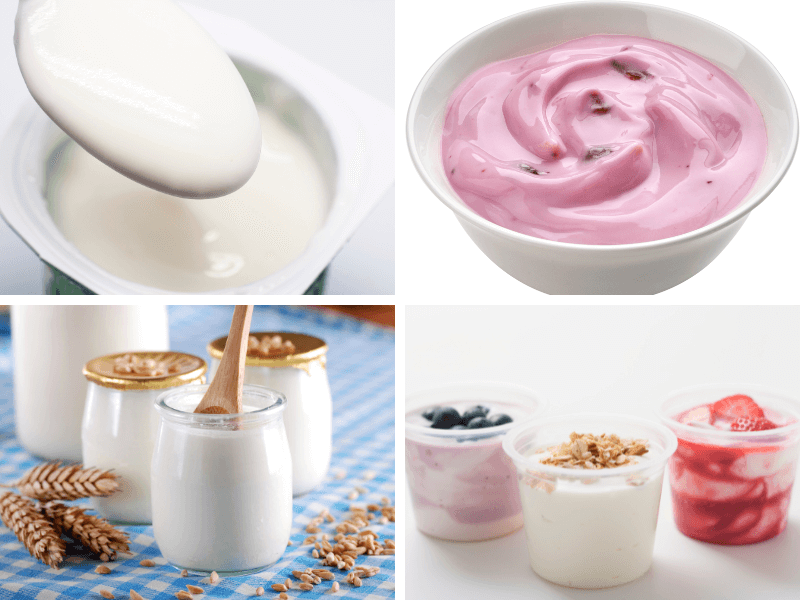The types of yogurt available today are numerous as you will see below. You probably have already realized this if you have recently visited a major U.S. grocery store dairy section and simply glanced around. It is quite an amazing sight if you’re a yogurt lover and you want options!
While variety is a good thing because it fills the needs of many consumers, it also creates confusion. We put together this list to help clarify the different types of yogurt available out there and to assist readers in finding the best yogurt to fit their needs.
- Regular Yogurt: This is the standard yogurt type that most people are familiar with. It’s made by fermenting milk with live bacteria cultures, which gives it a tangy flavor and creamy texture. Regular yogurt can be found in various fat levels, from full-fat to low-fat and non-fat options.
- Greek Yogurt: Greek yogurt is thicker and creamier than regular yogurt because it’s strained to remove whey. The straining process generally produces a higher protein content compared to regular yogurt. It’s made using similar bacteria cultures as regular yogurt but undergoes an additional straining process, which gives it its distinct texture and slightly tangier taste.
- Icelandic Skyr: Skyr is a traditional Icelandic yogurt that’s similar to Greek yogurt but typically even thicker and richer. It’s typically made by fermenting skim milk with live cultures and then thoroughly straining out the whey. However, brands like Icelandic Provisions sold in the U.S. make it with whole milk for extra creaminess. Skyr is known for its high protein content, velvety texture, and delicious flavors.
- Australian Yogurt: Aussie yogurt is not strained unlike Greek and the heavily strained Skyr. Its texture is closer to regular yogurt than Greek. Popular brands include Noosa and Wallaby.
- French-Style: French-style yogurt is a type of small batch yogurt set in small pots for several hours using simple ingredients. This differs from other types of yogurt made in large vats. It tends to be thicker and creamier than other types of yogurt due to the way it’s processed.
- Swiss Yogurt: This is thin yogurt with a tart taste. It is stirred in the vat to help produce its smooth, velvety texture. It is often considered creamier than Greek yogurt.
- Bulgarian Yogurt: Bulgarian yogurt is made from milk that has been fermented by two specific strains of bacteria: Lactobacillus bulgaricus and Streptococcus thermophilus. The unique combination of these bacterial strains, along with the traditional methods of fermentation and processing, gives Bulgarian yogurt its distinctive taste and texture. The yogurt is traditionally unstrained and features a tangy and mild sour taste. In Bulgaria it is called kiselo mlyako meaning “sour milk” in English.
- Probiotic Yogurt: Probiotic yogurt contains live bacterial cultures that are believed to offer health benefits, such as improved digestion and a stronger immune system. These cultures, such as Lactobacillus and Bifidobacterium, are added to the yogurt during the fermentation process. Most yogurt, but not all, contain some probiotics.
- Goat’s Milk Yogurt: It’s produced from the milk of goats. Goat milk is believed to be more easily digestible because of its smaller fat globules. People who are allergic to cow’s milk yogurts can sometimes tolerate goat milk yogurt
- Sheep’s Milk Yogurt: Sheep’s milk yogurt is known for its tart and sort of nutty taste. It is often praised for it digestibility even for some people who have lactose intolerance. It’s typically packed with protein, healthy fats, vitamins, and minerals.
- Plant-Based Yogurt: Plant-based yogurts are made from non-dairy sources like soy, almond, coconut, or oat milk. They undergo a similar fermentation process to traditional yogurt but use plant-based cultures instead of dairy-based ones. Plant-based yogurts cater to individuals with lactose intolerance or dietary preferences, offering a dairy-free alternative with varying textures and flavors.
- Flavored Yogurt: Flavored yogurts come in a variety of fruit flavors, sweetened with natural or artificial sweeteners. These yogurts often contain added sugars, flavorings, and sometimes thickeners to enhance taste and texture. They provide a convenient and tasty option for those looking for a sweeter yogurt experience. Most types of yogurt above are available with added flavors when sold commercially.
- Frozen Yogurt: The process of making frozen yogurt or “froyo” involves blending yogurt with sweeteners, flavorings, and sometimes fruit purees or other ingredients. The mixture is then frozen using a special machine that churns and freezes it simultaneously. This creates a smooth and creamy texture similar to ice cream.
- Cream Top Yogurt: Cream top yogurt is non-homogenized so the cream rises to the top. It can be stirred into the yogurt for a creamier product or skimmed from the top to reduce the fat and calories.
- Fruit on the Bottom & Blended: Fruit on the bottom means, well, the fruit is on the bottom of the yogurt instead of being mixed or blended in. Blended means the fruit is mixed into the yogurt.
- Whipped Yogurt: Whipped yogurt has had extra air add to it to create a fluffy and light texture. Although you receive an almost dessert-like texture with whipped yogurt, you also will be consuming less yogurt per serving compared to regular yogurt of the same size. Essentially, more air means less yogurt per container.
- Drinkable Yogurt: This is basically liquefied yogurt with a texture thin enough to drink. These are great for people on-the-go who want the convenience of a drink without having to worry about a spoon. In this category of types of yogurt, we would place products like kefir (similar to yogurt), smoothies, and any other drinkable yogurt products.

